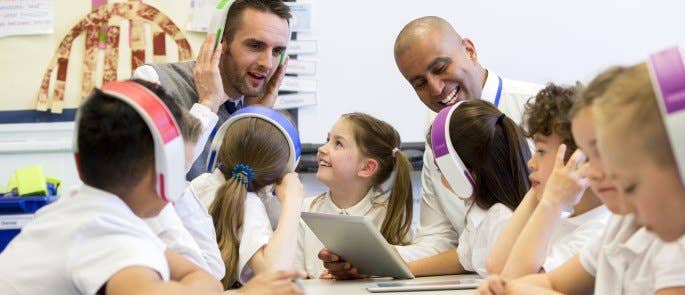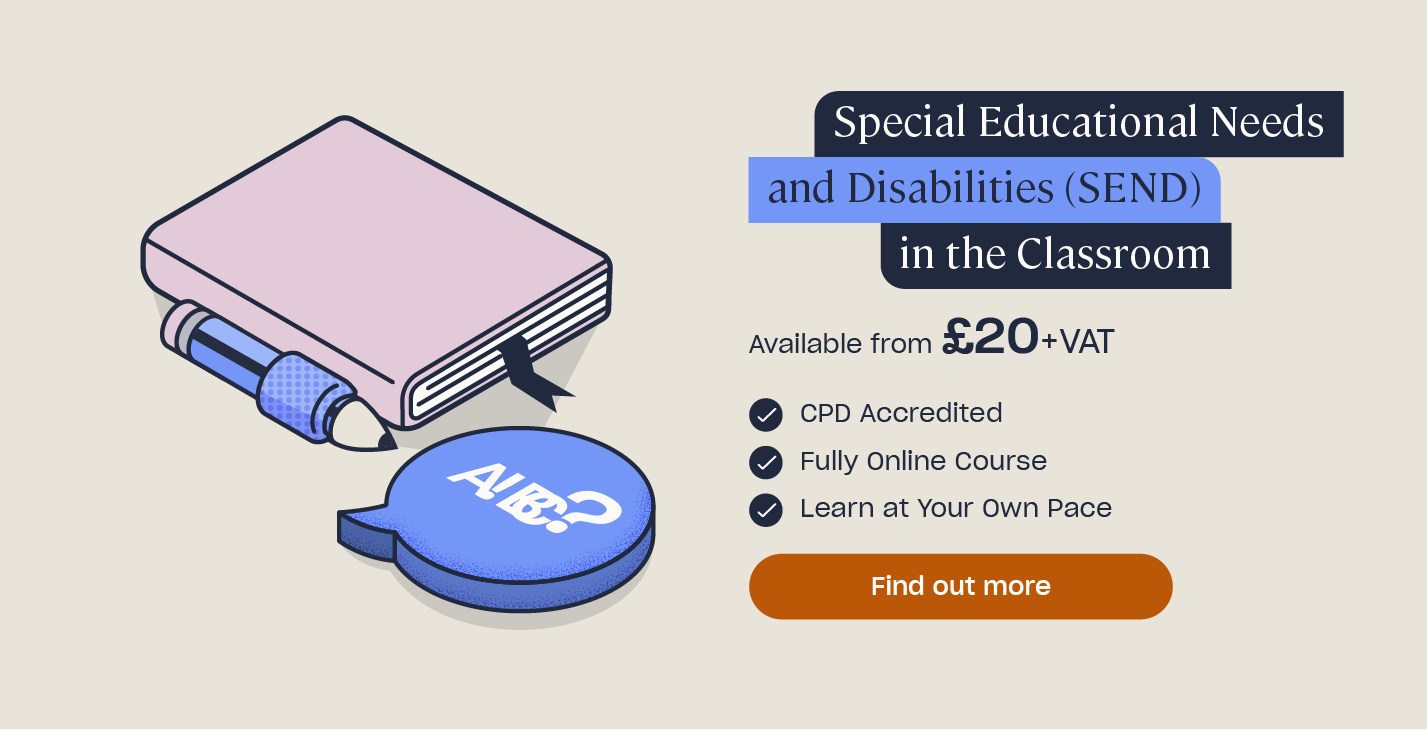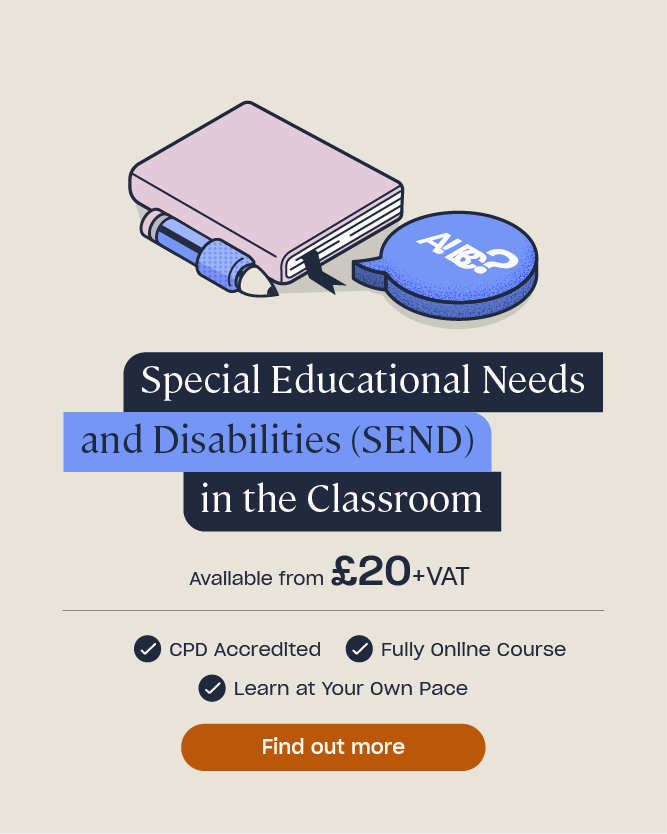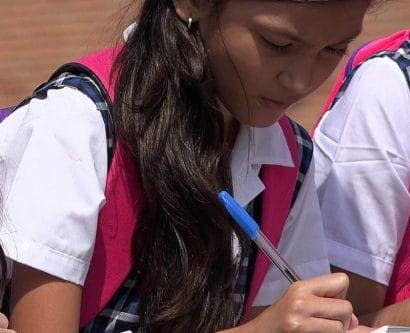What is the Graduated Approach?
All children have the right to access a broad and balanced curriculum, and as educators it is your responsibility to make those learning experiences accessible and inclusive. The Special Educational Needs and Disability (SEND) Code of Practice: 0 to 25 Years (DfE, 2015) – which we will refer to as the Code – provides guidance on the responsibilities of education, health, and care sectors to ensure the needs of children with SEND are met. The Code states that the best way in which to do this is to apply the Graduated Approach. In this article we are going to look at what the Graduated Approach is and how it works within an education setting.
We will also look at how to achieve a person-centred approach to supporting children and young people with SEND. This means that at every stage the views, wishes, and aspirations of the individual should be central to any provision offered. We will look at how the Graduated Approach can help achieve this.

What Is the Graduated Approach?
The Graduated Approach is a four-part continuous cycle made up of the following steps:
- Assess – use a range of assessment strategies to identify the specific support needs of the child.
- Plan – starting from the assessment, co-produce and share a plan, detailing the provision to be put in place.
- Do – implement the agreed provision.
- Review – monitor the learner’s progress and evaluate the success and impact of the support given.
The cycle then begins again. (Note: Whilst the steps of the cycle are simple, it is important that you do not approach it rigidly – for example, by distilling it into a Graduated Approach flow chart to be followed – as the key is to be responsive to individual needs.)
As teachers, you may be at different points in a great number of these assess, plan, do, review cycles at any given moment of the day – for each child, for each lesson, long-term cycles, short-term cycles, formal cycles, and informal cycles.

There will also be times when you don’t get through the entire cycle – when you need to go back to an earlier point because strategies aren’t working, or something new occurs, meaning you need to rethink and begin the process again. Constant review, incorporating the voices of the learners and their parents, is critical.
Want to Learn More?
Our SEND in the Classroom Course will teach you what you need to know to ensure you are fulfilling your legal responsibilities and following the Graduated Approach to SEND. It also discusses best practice for supporting children in each of the four areas of need, and what Universal Provision should look like.
Why Should Schools Use the Graduated Approach?
The Code recommends that a Graduated Approach is adopted with regards to identifying and meeting the needs of children with SEND. The Code broadly categorises special educational needs into four main areas: communication and interaction; cognition and learning; social, emotional, and mental health; and physical and sensory. However, children often have overlapping needs and may fall into several of these categories. The categories are not there to label children, but rather to point teachers in the direction of potentially useful support strategies.
Building an ongoing, holistic understanding of your pupils and their needs has been identified by the Education Endowment Fund (2020) as a key principle of effectively supporting children with SEND in mainstream education. Applying the Graduated Approach can help you to do this.

You will recognise this approach as something that is already part of your good teaching practice and you will be applying the principles to all your students. In the case of pupils who require SEN support, or have education, health, and care plans, you just need to apply the Graduated Approach with a tighter focus.
How Does the Graduated Approach Work?
Assess
The first stage of the cycle is assessment. Here, your assessments should provide you with an indication of where a child’s strengths and difficulties lie, the progress that they are making, and any barriers to learning they might be experiencing.
During the ‘assess’ phase, you are looking to gather as much relevant information as possible, to enable you to build a holistic picture of the individual. Joining the dots between all the assessment data available can help to create this picture.
Your assessment information should be wide ranging and come from a variety of sources, including the following.
Discussions With Pupils and Their Parents
To ensure a person-centred approach, the views, aspirations, and wishes of the individual should be at the heart of all SEND provision. Using tools such as one-page profiles can help explore and record children’s views. Conversations with parents can provide you with valuable insight into a child’s strengths and challenges at home, what motivates them, and if there is any relevant family history that might be useful to assessing their needs. Establishing successful home-school collaboration will help at every stage of the Graduated Approach.

Pupil Progress Data
A child not progressing in an expected way may be an indication that they are experiencing a barrier to learning, or have needs that are not being met. However, it must be remembered that slow progress does not necessarily mean that a child has SEND – and progress that is on track does not always mean that a child does not have SEND.
The following types of assessments can be used to provide pupil progress data:
- Summative assessment – activities that are completed at the end of a unit of work or term, to assess attainment or progress.
- Standardised tests – taken by all pupils, these enable you to look at trends across your class or year-group cohort. Age-standardised scoring allows wide-scale comparisons.
- Ipsative assessment – this makes comparison to a child’s own previous progress rather than to their peers or age-related expectations. It can be particularly empowering for children with SEND, as it centres around the learner and their personal best.
- Criterion-referenced assessment – this type of assessment marks progress against designated criteria, such as a high-frequency word checklist, or national curriculum attainment goals.
For children in Key Stages 1 and 2 who are not working at the levels of the Key Stage 1 national curriculum, it is a statutory requirement that you use the Engagement Model alongside your other assessment tools.
High-Quality Formative Assessment
This refers to a wide range of tools and strategies which allow you to assess for learning, looking at what is working (or not working), in order to plan the next steps. Formative assessment forms part of good teaching practice for all children (Teachers’ Standard 6), and is a vital component of the ‘assess’ phase of the Graduated Approach for children with SEND.

Such assessment could include:
- Teacher observations – your observations and everyday interactions with a child will form a large and important part of your assessment process, particularly in alerting you to a potential need for support. Remember to also gather observations from other teachers and support staff who work with, or have perhaps previously worked with, the child.
- Targeted screening tools – these can help pinpoint specific difficulties within the larger areas of need – for example, unpicking which particular areas of language a child is struggling with.
- Diagnostic assessment – this involves assessing prior knowledge, or seeing ‘where a child is’ before you begin work on a new skill, topic, or unit. This can take a range of forms, from straightforward tests to concept maps. Although it might seem counterproductive to assess children before they have started working on something, it can help you plan your approach and address any knowledge gaps.
Specialised Assessments
For higher levels of need, the Code acknowledges that specialised assessments from external agencies and professionals may be needed.

Specialists who might be involved in the assessment stage could include:
- Educational psychologists, or specialist teachers.
- Speech and language therapists.
- Paediatricians, psychiatrists, or mental health nurses.
- Occupational therapists or physiotherapists.
Your school or setting will have established links with specialists and a process for referring to them.
Medical Diagnoses
In the case of some SEND conditions, healthcare professionals will be involved. Medical diagnosis is different to identification of a special educational need – specific needs vary from one child to the next. You must not make any assumptions about a child based on a diagnosis. Always assess the needs and strengths of the individual learner.
Plan
The second stage of the Graduated Approach cycle is the planning stage, where you take your assessment findings and consider what provision could meet identified needs, or overcome observed barriers.

In collaboration with your SENCo, you will be able to select appropriate provision, considering the resources at your disposal. The strategies that you may use to support individuals with SEND can be categorised into a framework with different tiers of provision.
Universal Provision
Sometimes referred to as high-quality teaching or whole-class provision, this is what you provide for every learner in your everyday teaching practice.
High-quality teaching, differentiated and personalised for individual pupils, is the first step in responding to pupils who have or may have SEN.
SEND Code of Practice: 0 to 25 Years, DfE, 2015
Your basic good practice will involve differentiation (which is teacher-led) in your planning, delivery, and assessment. You then need to build personalisation (which is pupil-led) into your high-quality teaching to further respond to the needs of pupils with SEND.
By building in tailored adaptations or accommodations, you will often remove barriers and meet a child’s needs through your high-quality teaching alone. Tailored adaptations might be simple adjustments to your everyday practice – such as reframing instructions, allowing extra thinking time, adjusting seating plans, providing coloured photocopies, or making ear defenders available.
Targeted Provision
Even with a bed-rock of high-quality teaching, there will be times when Targeted Provision is needed, in order to meet a child’s particular need at that time.
Targeted Provision is short-term, with a defined end date, and is outcome-driven. Such interventions could include small groups working on a particular skill, or one-to-one interventions, such as precision teaching. Interventions can be based in or out of class.

Targeted Provision needs to be planned very carefully, of the highest quality, and always driven by the needs of the child.
You will need to consider:
- The intended outcome of the intervention.
- What strategy or intervention to select, how long it will run for, and how it will be structured.
- Who will deliver the intervention.
- Where the intervention will take place.
- When it will take place, and if the child will have to miss lessons.
- How you will help the child to relate their learning back to the classroom.
- How you will evaluate progress.
Our Hub article Effective Interventions in Education looks at some of these questions in further detail.
Specialist Provision
A further few children with SEND will require a much higher level of personalised support to ensure that they are able to make progress and thrive in school.
This is long term and personalised. It might be an ongoing intervention, such as daily sensory circuits to aid concentration, or a physical accommodation, such as a specialised chair.
With these types of provision, however, it is not a case of moving sequentially from one tier to another. A child’s learning journey is rarely linear, so the support should be offered flexibly. For example, some children with SEND may receive Targeted and Specialist Provision simultaneously, or move in and out of those tiers at different times of their school life.
Remember, sometimes there can be an element of trial and error to your planning – by continually applying the ‘assess, plan, do, review’ cycle, you can find the most effective strategies.
Evidencing Provision
Keeping an evidence trail of provision that has been put in place is important. When implementing any reasonable adjustments in the classroom, it is important to keep a record of this and share this information with your SENCo.
This can provide other teachers with details of effective strategies and also be useful for access arrangements. For example, it may highlight that a child can work effectively with a scribe or a reader – a strategy that would need to be emulated in statutory tests for them to work to their potential.

For any intervention (in-class or out) that is ‘additional to and different from’ Universal Provision, the following information should be kept:
- Entry data – a baseline assessment or starting point.
- Expected outcome – a projected outcome from the intervention.
- Actual outcome – end of intervention assessment.
- Attendance at the intervention – this is different to attendance in school.
- A brief commentary on their engagement and progress throughout the intervention.
The format this evidencing takes will depend on your school. They may use whole-class or group recording (e.g. provision maps), individual support plans (e.g. one page profiles), or a combination of both.
As a teacher, you will need to make sure that any support staff working with the child are aware of the intended outcomes, the strategies or interventions decided upon, and how to carry out any intervention chosen.
Do
This is the stage where you put your plan in practice.
The primary responsibility for this stage of the process lies with you, the teacher. You are responsible, even where interventions (in or out of class) are administered by another member of the team (Teachers’ Standard 2).
You will have decided on the approaches and provision you are going to try to implement in order to support the child with SEND. If the intervention is due to be conducted out of class, you should also have considered strategies to transfer the learning back to class learning.

What you actually do will be driven by the individual support needs identified.
When you are in the ‘do’ phase, it is important to remember that you will still be continually reviewing, assessing, and adapting on some level. If it becomes very clear that the strategy is not working for that individual, you should not wait until the agreed review date to get further advice and rethink the strategy. You may need to interrupt and begin the cycle again.
Review
This stage of the approach is where you gather input from the people involved in the provision (including the learner) and evaluate whether it has been effective.
Here you need to monitor impact – to ask ‘what difference has it made?’. As well as looking at concrete indicators (for example, if the aim of the intervention was to be able to blend four sound words, you will be able to assess its impact by testing that skill), you should also consider the view of the learner themselves as to the difference the provision has made to them.

In the review stage, you will need to ask:
- Has the approach or intervention met the expected outcome or target?
- Does this need to continue? If so, how long for?
- Does the strategy need to be adjusted in any way?
- Are there now other needs that need to be considered?
- Is the learner able to apply any learning developed in intervention to other learning?
The format your review will take may include:
- Person-centred review (PCR) meetings. These place the learner at the centre of the review process, and are often used in conjunction with materials such as the one-page profile or other person-centred thinking tools. The learner and their parents or carers attend the meeting, along with teaching and support staff, and the SENCo.
This format can be a collaborative, open, constructive, and reassuring process for families (White and Rae, 2015). - Meetings with parents. For children with SEND, the code advises bi-annual (secondary) or tri-annual (primary) review meetings. These may take the form of person-centred review meetings, as above.
- Pupil progress meetings. During these in-school formal meetings, you will have an opportunity to review the provision that was in place the previous term.
- Annual written reviews or reports. It is a formal legal requirement for schools to provide parents with at least one annual written review or report of their child’s progress, although many schools choose to do this more regularly.
Education, Health, and Care (EHC) Plans and the Graduated Approach
Although there are additional formal requirements for children who have EHC plans, such as a formal annual review carried out by the Local Authority, you should apply the same good practice with regards to the Graduated Approach described in this article.
The Graduated Approach provides a continuous cycle of assessment as children’s strengths and needs develop and change. This cycle forms a key part of good teaching practice for all children, but needs to be applied with a tighter focus for those children who require, or potentially may require, SEN support in schools. The children and young people in question, along with their parents and carers, should be involved throughout every stage of the process, so that it truly reflects and meets their individual needs.
Further Resources:
- What Is the Local Offer?
- How to Support SEMH in Schools
- SEND in the Classroom Course
- How to Support Children With Speech, Language and Communication Needs
- What are Specific Learning Difficulties (SpLDs)?
- How to Use the Engagement Model in Schools
- Supporting Pupils with SEN in the Classroom: Guidance for Teachers
- How to Support a Child with Autism in the Classroom
- 7 Creative Classroom Exercises for Teaching SEN Children
- ADHD Training
- Epilepsy Awareness Training











